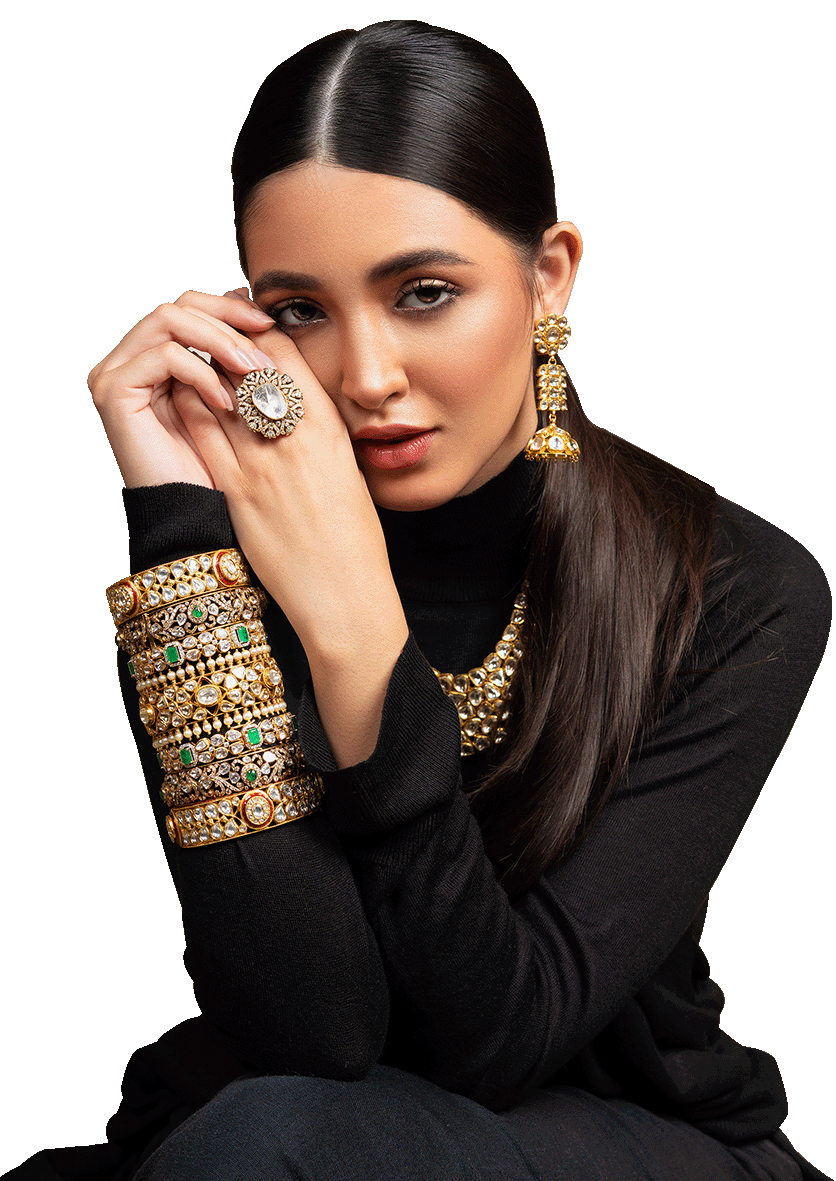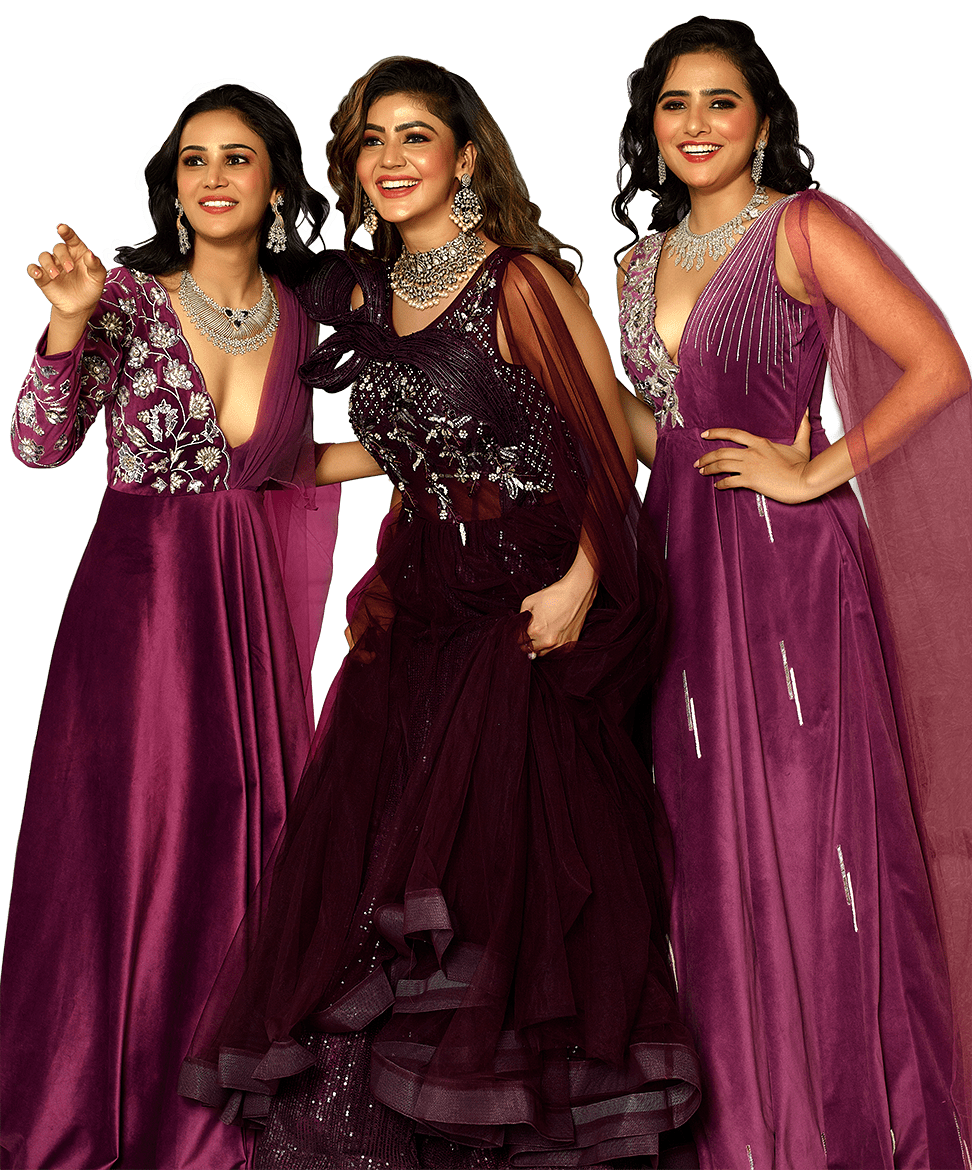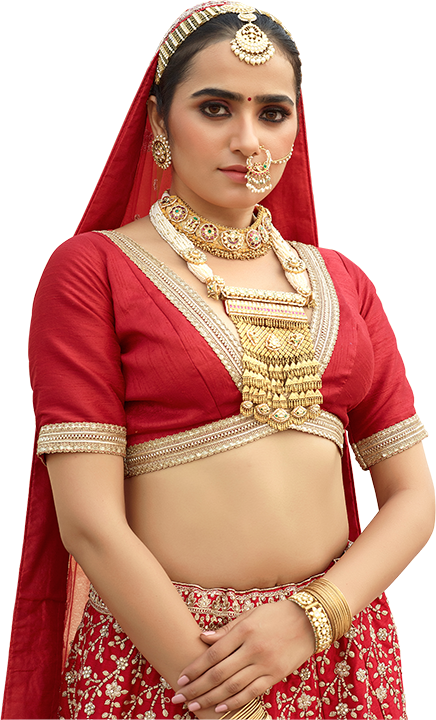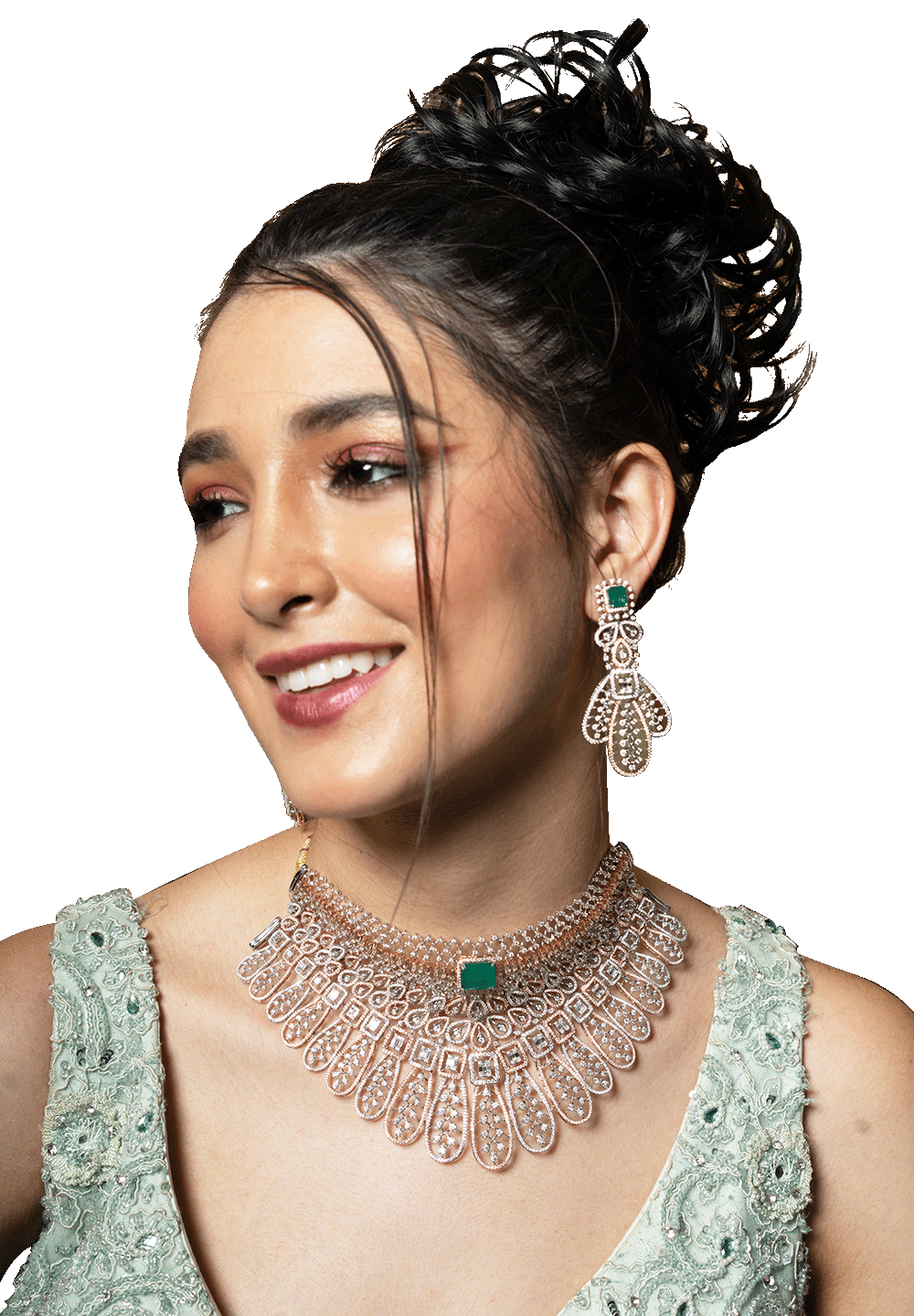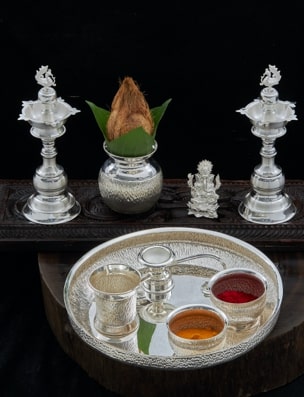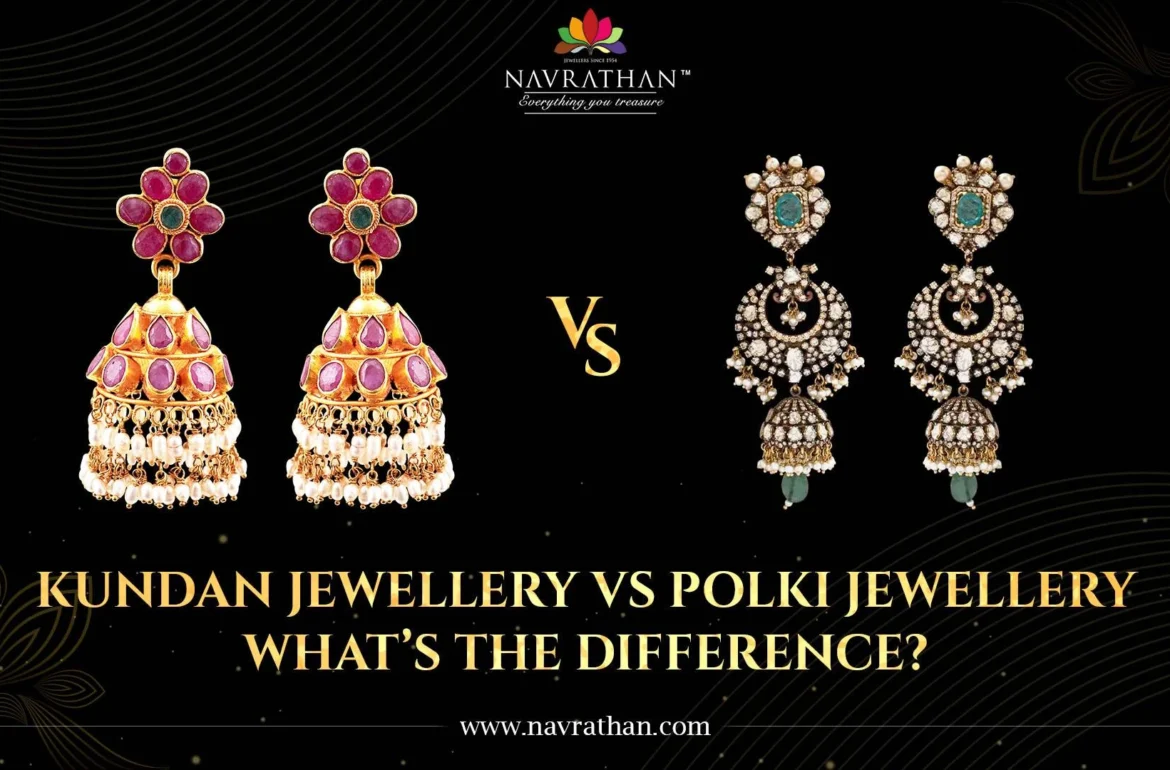
Are you confused between Kundan and Polki jewellery? Wondering which style suits your bridal or festive look best? You’re not alone! Many of us fall in love with the royal sparkle of both styles, but don’t fully know the difference. This blog breaks down Kundan Jewellery vs. Polki Jewellery to help you make an informed choice. Whether you’re preparing for a wedding, shopping for an heirloom, or simply admiring traditional Indian craftsmanship, we’ll guide you through everything—from types and materials to styling tips. Let’s uncover the true beauty and difference between Kundan and Polki jewellery together.
See Also: 10 Stunning Kundan Maang Tikka Designs for Your Wedding!
What is Kundan Jewellery?
Kundan jewellery is one of the oldest forms of traditional Indian jewellery, originating from the royal courts of Rajasthan and Gujarat. What makes it unique is the use of refined gold foil to set gemstones—like rubies, emeralds, sapphires—into elaborate designs. The stones are not cut but polished, and are backed by gold foils to give a rich, glowing effect. Kundan work is extremely detailed and requires fine craftsmanship.
In the debate of Kundan Jewellery vs. Polki Jewellery, Kundan stands out for its colorful, intricate patterns and its ability to complement bridal or festive attire with grandeur. It’s not about diamonds but about artistry. Contact us today and get the best Necklace set online in India!
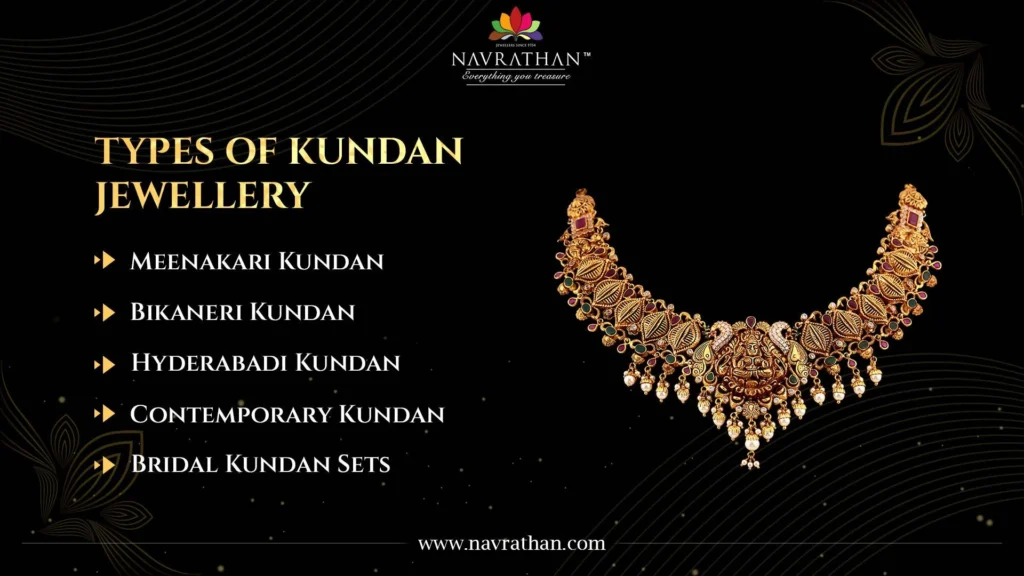
Types of Kundan Jewellery
When exploring kundan jewellery types, you’ll find a variety of forms, each with a unique aesthetic. Here are some popular ones:
1. Meenakari Kundan – This is a blend of Kundan with colorful enamel work (meenakari) on the reverse side. It offers dual looks—one rich in stones, the other vibrant with patterns.
2. Bikaneri Kundan – Originating in Bikaner, this style uses higher gold content and detailed foil work. It’s one of the purest and most expensive kundan jewellery types.
3. Hyderabadi Kundan – Famous for its heavy gold presence and use of pearls, this style is ideal for grand bridal looks and regal appeal.
4. Contemporary Kundan – This modern twist includes lightweight designs with pastel stones, ideal for younger audiences and fusion outfits.
5. Bridal Kundan Sets – A full set with necklace, earrings, maang tikka, and bangles. Often worn during weddings, this type defines the bride’s grandeur.
What is Polki Jewellery?
Polki jewellery is made using uncut, raw diamonds—also known as Polki diamonds. These diamonds are naturally mined and left untreated, which gives them an organic, earthy charm. Unlike the refined finish of Kundan, Polki jewellery offers a rustic yet regal look, rooted in Mughal design traditions.
In the conversation around Kundan Jewellery vs. Polki Jewellery, Polki is prized for its use of polki diamond jewellery—making it heavier, more valuable, and usually more expensive. These diamonds are set in gold, often with elaborate detailing to enhance the brilliance of the raw stones. Polki is perfect for those who love heirloom-worthy pieces with vintage elegance. Contact the best online jewellery shop in India today!
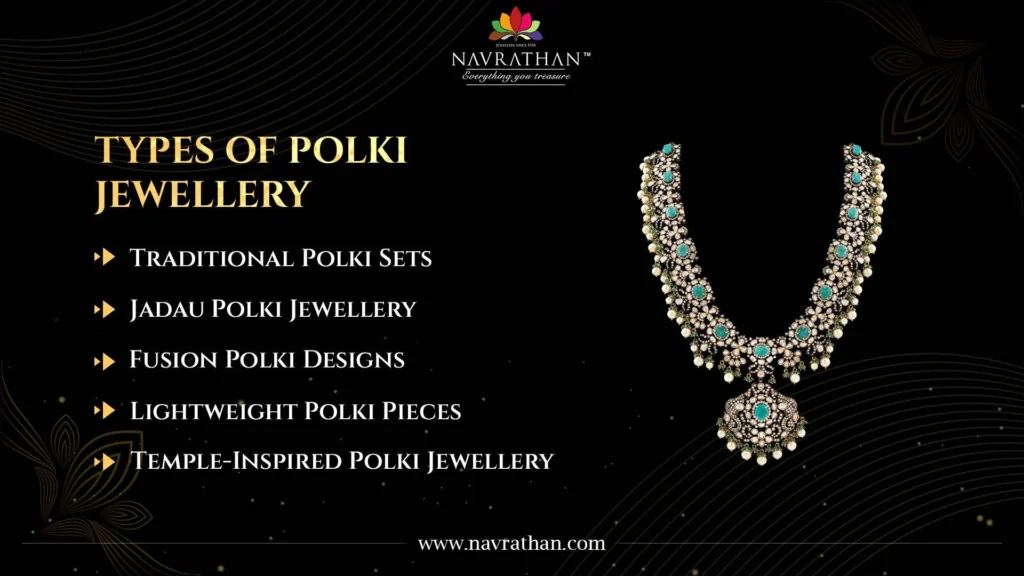
Types of Polki Jewellery
Let’s dive into the different styles of polki diamond jewellery that define timeless beauty:
1. Traditional Polki Sets – These include chunky necklaces, earrings, and bangles with raw diamonds set in thick gold. Ideal for bridal wear, they offer maximum shine and grandeur.
2. Jadau Polki Jewellery – Often mistaken for Kundan, Jadau is actually a technique used in both styles. In Polki, it’s used to set uncut diamonds without using adhesives—only heat and pressure.
3. Fusion Polki Designs – A blend of Polki with contemporary shapes and pastel-colored enamel. Great for those who want a touch of tradition with a modern feel.
4. Lightweight Polki Pieces – These are minimalist designs perfect for casual or semi-formal occasions. They bring the charm of diamonds without being overwhelming.
5. Temple-Inspired Polki Jewellery – Inspired by temple architecture and deities, this style fuses South Indian heritage with the brilliance of Polki diamonds. It’s bold, divine, and culturally rich.

Key Differences Between Kundan and Polki Jewellery
| Aspect | Kundan Jewellery | Polki Jewellery |
| Stone Type | Uses highly polished semi-precious or glass stones, backed with gold foil to create a glowing appearance. | Uses raw, uncut diamonds (Polki) that retain their natural form and radiate a more organic, muted shine. |
| Base Material | Crafted with thin sheets of highly refined gold (24K) foil, acting as the base to hold stones in place. | Made with solid gold (usually 22K), where diamonds are set directly into the structure without foil backing. |
| Appearance | Offers vibrant, colorful aesthetics with detailed designs, often highlighted by meenakari work on the reverse. | Gives a royal, rustic, and earthy look due to the natural brilliance of uncut diamonds and minimal color use. |
| Weight | Typically lighter in weight, especially in modern and fusion designs; bridal pieces may be heavier. | Usually heavier due to the dense gold framework and weight of real Polki diamonds. |
| Cost | More budget-friendly as it uses faux or semi-precious stones; pricing depends on gold content and workmanship. | More expensive due to the use of natural, uncut diamonds and high gold content, making it a luxury investment. |
| Craftsmanship Origin | Originated in Rajasthan and flourished under Mughal patronage; known for its artisanal, handmade precision. | Also rooted in Mughal traditions but associated closely with Rajput heritage and heirloom-style jewellery. |
| Best For | Ideal for festive occasions, traditional functions, and those seeking artistry over diamond value. | Best suited for bridal jewellery, heritage collections, and those looking for valuable investment pieces. |
| Common Styles | Meenakari Kundan, Hyderabadi Kundan, Bikaneri Kundan, and lightweight modern designs. | Jadau Polki, Temple-style Polki, Fusion Polki with enamel or gemstone accents. |
See Also: Top 8 gold temple jewellery designs from Navrarthan
Which One Should You Choose?
1. Consider Your Occasion – For weddings or grand events, both styles work. Choose polki diamond jewellery for luxury and impact. Go for kundan jewellery types if you want vibrant and traditional detail.
2. Check Your Budget – Polki is pricier due to the use of real, uncut diamonds. Kundan offers a more budget-friendly alternative without compromising on aesthetics.
3. Think About Your Outfit – Kundan complements colorful lehengas and sarees beautifully. Polki, with its natural sheen, matches well with neutral or royal tones.
4. Choose Based on Weight – Prefer lightweight jewellery for long wear? Opt for modern Kundan styles. Love the feel of heritage pieces? Polki will win your heart.
5. Your Personal Style – Are you drawn to intricate artistry and enamel work? Kundan’s your pick. Do you prefer raw, natural brilliance? Polki is your match.

Conclusion
In the debate of Kundan Jewellery vs. Polki Jewellery, there’s no wrong choice—only what speaks to your heart. Kundan charms with its colorful finesse and artistry, while Polki stuns with its raw elegance and diamond sparkle. Whether you’re dressing for tradition or making a statement, understanding the difference between Kundan and Polki jewellery helps you invest in a piece that lasts a lifetime. Choose what reflects your soul and style best—and let your jewellery do the talking.
At Navrathan, the best online jewellery shop in India, we celebrate heritage and craft jewellery that speaks of timeless beauty. For decades, we’ve delighted connoisseurs across India with breathtaking designs, intricate detailing, and ancient techniques. Our collections offer a rich range of kundan jewellery types, elegant polki diamond jewellery, and masterpieces that blend traditional and modern design sensibilities.
FAQs
1. What is Kundan jewellery?
Kundan jewellery is a traditional Indian style made by setting polished gemstones in pure gold foil. Known for its intricate craftsmanship and colorful designs, it’s a popular choice for festive and bridal wear due to its rich, royal look.
2. Is Polki better than Kundan for bridal jewellery?
Polki is often preferred for bridal jewellery because it features real, uncut diamonds that offer a luxurious and timeless appeal. While Kundan is more colorful and artistic, Polki provides greater value and sparkle, making it ideal for grand occasions.
3. What is Polki jewellery?
Polki jewellery uses raw, uncut natural diamonds set in gold. It originated during the Mughal era and is valued for its vintage charm, organic shine, and high craftsmanship. It’s considered premium and is often used in heirloom bridal pieces.
4. How do you tell the difference between Kundan and Polki?
Kundan uses polished glass or gemstones with gold foil backing, giving a colorful and glowing look. Polki uses uncut diamonds without foil, resulting in a more rustic, natural shine. Polki is heavier, pricier, and has a more vintage appearance.
5. Which is more expensive: Kundan or Polki?
Polki is generally more expensive than Kundan because it features real, uncut diamonds. Kundan, though crafted in gold, uses glass or semi-precious stones, making it more affordable. The difference lies in the materials, craftsmanship, and long-term value.
